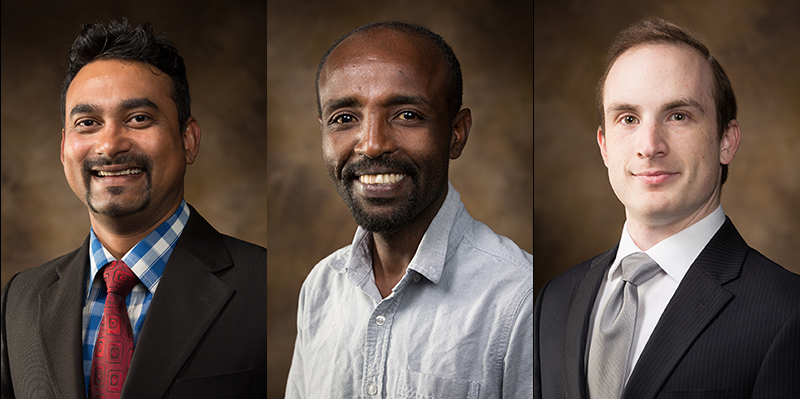Research Reveals Insights Into Optical Properties of Plasmonic Nanostructures

From left: Pijush K. Ghosh, Desalegn T. Debu and David A. French.
FAYETTEVILLE, Ark. – University of Arkansas researchers have helped define the optical properties of plasmonic nanostructures, work that could lead to improved sensors in security and biomedical devices, and have applications in solar cells. The research team in the Department of Physics recently published its findings in the journal PLOS ONE.
Plasmons are waves of electrons on the surface of a metal. The frequency of these electronic waves can be altered to couple with light by changing the particle size, shape, material and surrounding environment. The plasmons can increase light intensity and focus the light down to nanoscale volumes, which can be useful for a variety of nanoscience applications.
The core of the work is the subject of graduate student Pijush K. Ghosh’s master thesis in physics. Ghosh collaborated with fellow graduate students Desalegn T. Debu and David A. French for the journal article, titled “Calculated thickness dependent plasmonic properties of gold nanobars in the visible to near-infrared light regime.” The students are part of a physics research group led by assistant professor Joseph Herzog.
This work explores the optical properties of rectangular-shaped gold nanoparticles, in particular how they scatter light and the strength of the scattered light near the nanoparticle. The researchers determined how variations in the structures’ geometry affected how they coupled with light, making it easier to work with structures that aren’t perfectly square. The findings could enable plasmonic devices, such as sensors, to be more accurately tuned for a specific application.
“Making nanostructures with perfectly square corners is difficult using common nanofabrication techniques,” Ghosh said. “In our work, we investigated realistic structures with rounded corners. The work determined the difference in resonance wavelength of round-corner and sharp-corner nanobars. We also found how the spectrum precisely shifts as you make thicker nanobars. This reveals insight into another dimension of the structures that allows for more control and tunability of these plasmonic nanostructures.”
Ghosh is pursuing his doctorate in electrical engineering. He is working on a thin-film capacitor project with funding from the U of A’s Center for Power Optimization of Electro-Thermal System, a National Science Foundation-sponsored center.
Contacts
Joseph Herzog, assistant professor
Department of Physics
479-575-4217,
jbherzog@uark.edu
Bob Whitby, feature writer
University Relations
479-575-4737,
whitby@uark.edu
Headlines
PetSmart CEO J.K. Symancyk to Speak at Walton College Commencement
J.K. Symancyk is an alumnus of the Sam M. Walton College of Business and serves on the Dean’s Executive Advisory Board.
Faulkner Center, Arkansas PBS Partner to Screen Documentary 'Gospel'
The Faulkner Performing Arts Center will host a screening of Gospel, a documentary exploring the origin of Black spirituality through sermon and song, in partnership with Arkansas PBS at 7:30 p.m. Thursday, May 2.
UAPD Officers Mills and Edwards Honored With New Roles
Veterans of the U of A Police Department, Matt Mills has been promoted to assistant chief, and Crandall Edwards has been promoted to administrative captain.
Community Design Center's Greenway Urbanism Project Wins LIV Hospitality Design Award
"Greenway Urbanism" is one of six urban strategies proposed under the Framework Plan for Cherokee Village, a project that received funding through an Our Town grant from the National Endowment for the Arts.
Spring Bike Drive Refurbishes Old Bikes for New Students
All donated bikes will be given to Pedal It Forward, a local nonprofit that will refurbish your bike and return it to the U of A campus to be gifted to a student in need. Hundreds of students have already benefited.




